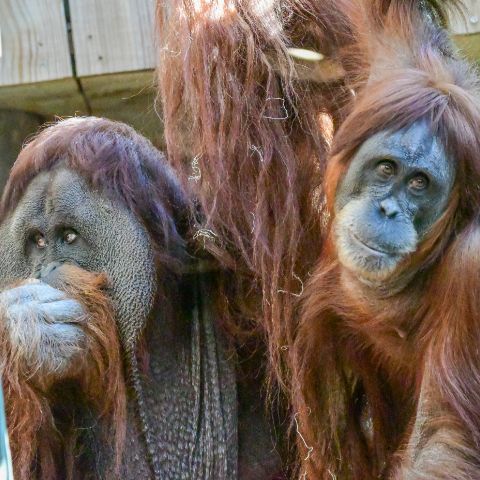Summary of OKC Zoo’s Sumatran Orangutans Moving to New AZA Zoos:
The Oklahoma City Zoo is saying goodbye to two Sumatran orangutans, Elok and Negara, as part of the AZA’s Species Survival Plan for orangutans. Elok, a 25-year-old male, and Negara, a 31-year-old female, are moving to new zoos to hopefully find mates and contribute to the species’ future. Despite efforts, they did not produce offspring together. Both are beloved by staff and visitors, with Elok known for his curiosity and engagement, while Negara is more independent. Their move will also make space for the zoo’s gorillas and chimpanzees. Visitors are encouraged to bid farewell to them before their departure.
- The relocation of Sumatran orangutans Elok and Negara from OKC Zoo to other AZA-accredited zoos.
- The conservation efforts and critical status of the Sumatran orangutan species.
- The role of the AZA’s Species Survival Plan® in orangutan breeding and genetic diversity.
- The personalities and behaviors of Elok and Negara observed by the OKC Zoo staff.
- The impact of their move on both the orangutans and the zoo community.
The Oklahoma City Zoo is bidding farewell to two cherished Sumatran orangutans, Elok and Negara. These majestic animals will move to new Association of Zoos and Aquariums (AZA) member zoos, following strategic recommendations from the AZA’s Species Survival Plan® (SSP) for orangutans. This transition represents a vital step in advancing conservation efforts while enhancing the genetic diversity of these critically endangered apes.
Sumatran orangutans, native to Sumatra, Indonesia, are captivating yet critically endangered creatures, with only approximately 14,000 left in the wild. Their decline has been propelled by factors such as deforestation and habitat fragmentation. The International Union for Conservation of Nature (IUCN) lists them as critically endangered, underscoring the urgency of conservation measures. Experts fear that these orangutans, along with their two close relatives, could face extinction within the next 50 years unless substantial conservation efforts are undertaken.
Elok, a 25-year-old male, and Negara, a 31-year-old female, have been integral parts of the OKC Zoo since their respective arrivals in 2008 and 2016. Brought together under a breeding recommendation from the AZA’s SSP, the hope was for them to become parents. However, their interactions did not lead to reproduction. Despite this, both orangutans are deemed genetically desirable. Their relocation is anticipated to place them in environments where they might find compatible mates, potentially enhancing the population’s genetic pool.
The SSP program aims to manage zoo animal populations with a focus on conservation goals, promoting sustainable breeding programs that avoid inbreeding and ensure healthy future generations. Within this framework, Elok and Negara’s move to other facilities is an important strategic decision to boost genetic diversity and foster potential breeding success.
The zoo staff at OKC has formed strong bonds with Elok and Negara, who have distinctive personalities. Elok stands out with his inquisitive nature and intellectual engagement, often delighting visitors at his habitat window. His playful antics during zoo events, like "Haunt the Zoo," highlight his social nature. Food-based enrichment, such as durian, a pungent fruit from his native Sumatra, is among his favorites. He also enjoys engaging in physical enrichment activities, like puzzle-solving and bubble play.
Negara, meanwhile, possesses a more reserved demeanor. She enjoys solo time and exerts her independence by expressing preferences, such as blowing raspberries when staff delay. Her elegant appearance and self-sufficient behavior have endeared her to visitors, who often inquire about her impeccable grooming. Despite her independent nature, she actively participates in enrichment activities, which play a crucial role in mental stimulation and well-being.
The impending departure of Elok and Negara will undeniably impact the zoo’s landscape. Their absence is seen as a bittersweet opportunity, allowing more flexibility and resources to be allocated to the Western lowland gorillas and chimpanzee family residing at the zoo. Plans for their moving timelines have been communicated to the public, inviting fans to bid farewell and celebrate the memories shared with these remarkable creatures.
As Elok potentially moves by the end of May, and Negara later in the year, the OKC Zoo emphasizes the narrative of hope and proactive conservation. The dedicated staff remains committed to the welfare of all animals within their care. This transition showcases an essential component of zoo management: leveraging expert knowledge in zoology and wildlife conservation to support broader ecological goals.
Visitors to the OKC Zoo have been offered unforgettable glimpses into the lives of Sumatran orangutans, along with the zoo’s celebrated Great EscApe habitat. As part of ongoing conservation education efforts, the zoo highlights the broader global context of these animals and the crucial work required to protect them.
Throughout this transition, the OKC Zoo’s primary commitment remains unwavering: advancing the cause of wildlife conservation while nurturing the existing bonds between animals and humans. The impending move of Elok and Negara illustrates a vital collaboration among accredited zoos worldwide, striving towards the sustainable future of Sumatran orangutans.


